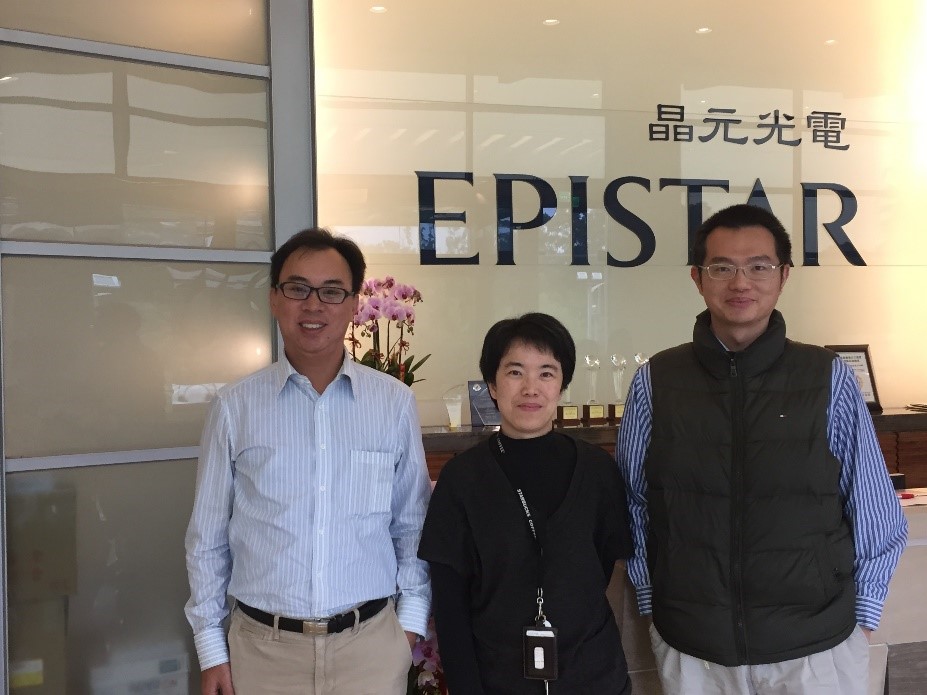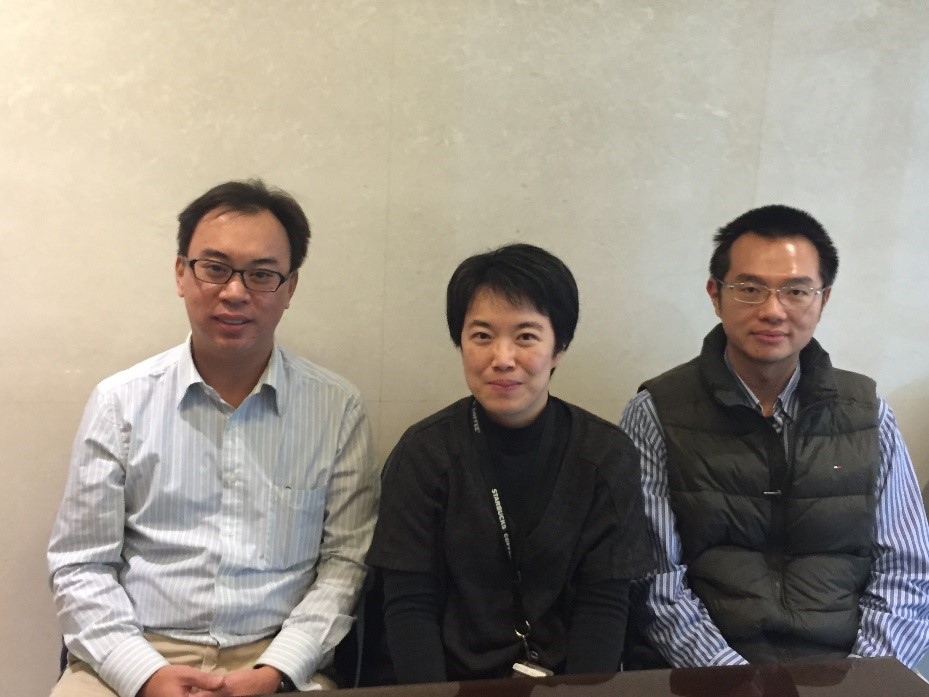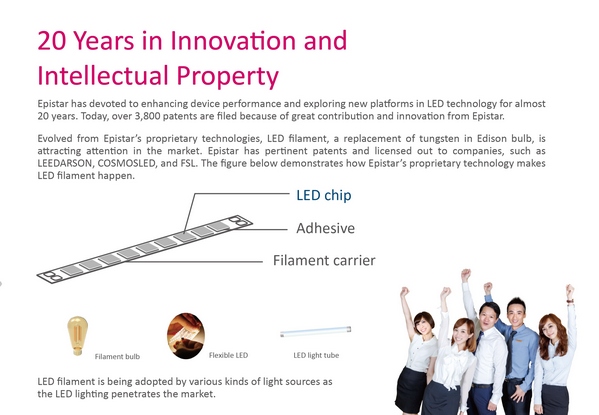LED filament bulbs is an emerging product on the market that holds great market potential, with high visibility in the Middle East, Americas and Europe. It is also one of the most important lighting products in the Asian manufacturing supply chain. For instance, Taiwanese LED manufacturer Epistar currently holds crucial LED patents that comprise the core technology in LED filament bulbs. In an exclusive interview with Epistar managers and directors including Alexandar Wang, Director of the company’s Marketing Center Segment Group, the company’s Intellectual Property Division Meng-chun Kuo, Director, and Walter K.Y. Chou, Manager of the company’s Intellectual Property Department III, these managers revealed LED filament bulb market’s latest trends, technology development, and patent strategy deployment.
 |
|
Epistar interviewees left to right: Alexandar Wang, Director of Marketing Center Segment Group, Meng-chun Kuo, Director of Intellectual Property Division, Walter K.Y. Chou, Manager of Intellectual Property Department III. (LEDinside) |
LED filament bulbs replace traditional tungsten filament bulbs as decorative light source
The LED filament bulb became popular in the lighting market mainly because major buyers and consumers in decorative lighting, art lamps, chandeliers and classical luminaires were gradually replacing conventional light sources, including filament bulbs and halogen light sources with LED lights. Previously, traditional LED bulbs failed to meet the aesthetic demands of traditional luminaire manufacturers, which paved the way to LED filaments emergence on the market.
LED filaments are mainly applied in A19, A60 and A55 products. Main bulb specs are centered on 450 lm bulbs that use four LED filaments designed to meet B35 and F35 specs, for 250 lm LED candle lights the design uses three filaments. In the application sector, the LED filament bulbs are applied in vintage bulbs, candle lights, light bulbs, and decorative lights for existing and replacement demands. The filament bulb market has continued to expand.
 |
|
Epistar interviewees left to right: Alexandar Wang, Director of Marketing Center Segment Group, Meng-chun Kuo, Director of Intellectual Property Division, Walter K.Y. Chou, Manager of Intellectual Property Department III. (LEDinside) |
LED filament bulb technology trends
LED filaments are the core technology in LED filament bulbs, while other components are not too different from other LED bulbs. The scope of the filament technology covers LED chips, adhesives, phosphor powder and substrates. A critical requirement in LED filament design is excellent light transmission, which has the advantages of zero obstruction in the emitted light shape. The LED filament can be made with sapphire, glass, and transparent ceramic substrates. Metal substrate LED filaments are currently rarely seen on the market, due to the high soldering fail rate.
Even though glass substrates are less costly the filament has very low thermal dissipation. Filament bulb designs are therefore restricted by glass filament’s thickness of 1 mm to 2 mm. In comparison, sapphire substrates are thinner with a substrate thickness of 0.8 mm to 1 mm. Moreover, its quality matches transparent ceramic substrates, yet it is still slightly more costly than glass. Sapphire substrate’s comprehensive supply chain has made it the most prominent filament material found in LED filament bulbs, taking up 70% to 80% market share. Trailing in second is transparent ceramic substrate filaments 20% market share, followed by glass filaments mere 10%, said Epistar. Under these conditions, the retail price of LED filaments on the market can range from US $0.15 to US $0.3 or even higher.
In addition, phosphor powder and patent protection also led to LED filaments wide price disparities. Advancements in manufacturing technology and processing has solved LED filaments yield rate issues, and on top of using reliable LED dies, the market is also gradually using high quality phosphor with excellent color rendering properties. For example red phosphor has high color rendering properties that resulted in large pricing differences. Epistar also projects LED filament bulbs will encounter the same price plunge issues as LED bulbs, which will also propel the product’s market penetration.
 |
|
A diagram of Epistar's LED filament. (Photo courtesy of Epistar) |
Manufacturers increasingly value LED filament bulb patents
Epistar currently supplies a selection of diverse LED dies to its lighting clients, which mainly comprises general LED bulbs and a couple filament bulb clients. Manufacturers are placing more emphasis on LED filament bulbs patents because one of the crucial LED filament technologies involves adhering several LED chips onto a transparent substrate to emit a better light shape and can improve luminous efficacy. In 2004, Epistar was granted this key technology patent from intellectual property offices in U.S., Europe, China, and Taiwan, and has in turn licensed this particular patent to Cosmoled, Leedarson, and FSL. Epistar is working and negotiating with interested clients, and aims to strengthen and expand strategic partnerships through LED patent licensing. It is hoped through these initiatives, the company will be able to further expand its market presence and establish a market competitive edge.
The LED filament bulb market size will reach approximately 150 million bulbs by 2016, estimated Epistar. By 2017 the market is expected to double in size to reach 300 million bulbs, and soar to 600 million bulbs by 2018, projected the LED manufacturer, and has immense potential in the LED lighting market. Based on its existing LED filament patents, Epistar will continue to provide related solutions to its clients, through R&D to facilitate the commoditization of LED filament bulbs.
(Author: Ivan Lin, Editor-in-Chief, TrendForcehttp:// Translator: Judy Lin, Chief Editor, LEDinside)





 CN
TW
EN
CN
TW
EN








